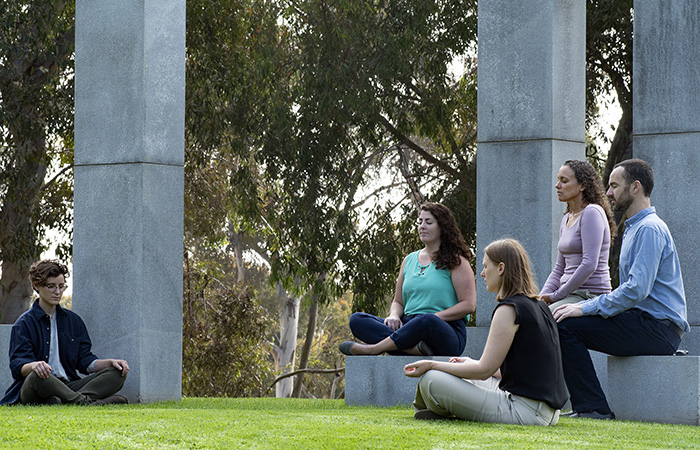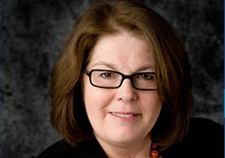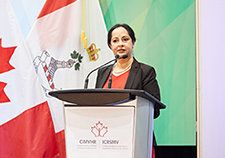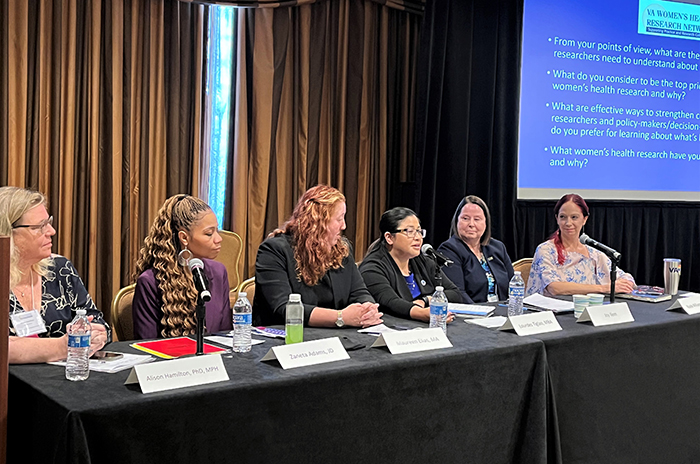Office of Research & Development |
 |


Dr. Ariel Lang (second from right) practices meditation with associates from her lab. She’s focusing on complementary and alternative techniques, such as yoga and meditation, as a therapy for patients with PTSD. (Photo by Christopher Menzie)
August 25, 2021
By Mike Richman
VA Research Communications
About two decades ago, Dr. Ariel Lang was completing her clinical internship and post-doctoral fellowship in clinical psychology at the University of California, San Francisco. One of her mentors was Dr. Paul Ekman, a psychologist and professor at the university.
Ekman was a pioneer in the study of emotions and their relation to facial expressions. He forged a friendship with the Dalai Lama, the traditional high priest of Tibetan Buddhism. The two co-authored a book in which they engaged in a conversation about human emotions from a Buddhist philosophy and the pursuit of psychological fulfillment. The book, published in 2009, stressed the importance of meditation.
Knowing Ekman had been impactful in her career development, Lang eagerly read the book.
“Out of that, I became really interested in the ways in which they were talking about the philosophy behind meditation and how it seemed to match with some of the struggles that we see in people with PTSD,” she says. “With PTSD, there’s a lot of social withdrawal and loss of positive emotions like excitement and joy. Meditative approaches can create the opposite of those things. Compassion-based meditation, which is based on Buddhist tradition but has been adapted so anyone can participate, helps people feel warmth toward others. I became interested in meditation conceptually based on that.
“[The authors] weren’t thinking about PTSD,” she adds. “But the book just spoke to me in terms of what it might bring to PTSD care. That was definitely my inspiration for starting on a lot of my work.”
"If you ask Veterans what they want as a part of their overall wellness program, meditation is something that they want. VA listens to Veterans."
Today, Lang is the director of the Center of Excellence for Stress and Mental Health at the VA San Diego Healthcare System. She’s also a professor at the University of California, San Diego. Her research and clinical work are focused on trauma-related disorders, including the use of complementary and alternative techniques, such as meditation, for treating PTSD.
Lang has been involved with six studies related to meditation, including two projects that she led. She is exploring the following types of meditative practices for their potential to ease PTSD symptoms in Veterans:

VA Researcher Named One of U.S.’ Top Female Scientists

Million Veteran Program director speaks at international forum

2023 VA Women's Health Research Conference

Self-harm is underrecognized in Gulf War Veterans
Meditation has been linked to a number of benefits, including decreased anxiety and lower cardiovascular risk. But research on the potential benefits of meditation for patients with PTSD has been inconclusive. For some patients, meditation appears to provide strong benefits. But others may not notice a change. Veterans who are interested in meditation, Lang says, should try different types to see which one is most helpful.
Lang spoke to VA Research Currents:
VA Research Currents: What are the benefits of meditation as a therapy for PTSD?
We’re just learning that. Asking about what meditation does for PTSD is like asking about what medication does for PTSD. It really depends on which meditation we’re talking about, just like it would depend on which drug we’re talking about. Different meditations potentially do different things.
You can think of PTSD in some way as an attention disorder. What happens when someone has a flashback or an unwanted memory is their attention is diverted to someplace else, someplace they don’t want to think about right now. If you think about it that way, managing PTSD is about keeping your attention where you want it to be. One thing that meditation does—and this is certainly true of mindfulness meditation—is help to train attention. This is also why I’m interested in yoga because yoga trains attention. In fact, yoga will give you feedback if you’re not paying attention. So if you’re not paying attention and you’re trying to balance on one foot, you’re going to fall over.
The key with a meditation like compassion meditation or loving kindness meditation might be one’s sense of belonging or the ability to connect with others. Compassion meditation and loving kindness meditation are similar in that they focus on thinking about others in a more positive way, but they are based on distinct Buddhist concepts, and the practices are different. PTSD is often characterized by social withdrawal. Veterans often struggle with a sense of “in group” and “out group.” It can be hard for them to relate to civilians, or certain people may remind them of former combatants. Meditations that focus on compassion and relief of suffering can be a really good match for those Veterans.
PTSD is also a disorder of arousal, so you get the jumpiness, the physical sensations, the panic-like symptoms. It looks like meditations such as mantram repetition and transcendental meditation may be really helpful for easing hyperarousal symptoms. Ultimately, I would like to someday be able to guide people, “This is the way your PTSD is manifesting itself. Let’s try this first because we think this type of treatment may match the trouble that you’re having.”
Is mindfulness synonymous with yoga?
No. But yoga often incorporates mindfulness. Mindfulness is just focusing on the present moment with an attitude of non-judgment and non-reactivity. In the case of yoga, that focus will be on pairing the breath with the movement. One can focus on many things during a mindfulness practice, though. Breathing, walking, and eating are examples. Mindfulness ends up being a building block for many practices. In order to do the compassion meditation we do, we first teach mindfulness. But yes, in terms of what they would do for PTSD, namely help with attention control, mindfulness and yoga are pretty similar.
Should meditative approaches be stand-alone therapies for patients with PTSD, or should they be used as a complementary therapy with one of VA’s main trauma-focused psychotherapies and-or medication?
It can be any of the above. We can’t at this point tell patients we know what’s going to be best for them. We have our guesses based on averages, but an average never predicts to a person. At this point, I wouldn’t recommend meditation as the first thing you ever try. So if somebody comes to me, and they have newly diagnosed PTSD, I’m going to recommend a trauma-focused therapy, cognitive processing therapy or prolonged exposure, because that’s my best bet. On average, those are the most effective things that we have. Some people are going to go do one of those therapies, and they’re going to get a whole lot better. End of story.
But a lot of other people are going to tell me, “Doc, no way, I’m not talking about my trauma.” So what do you do for those people? That’s one of the places where meditation comes in. It’s another therapy we can try. We’ll see what benefit we get. You do 100% better, you’re merrily on your way. If you don’t, maybe you’ve found some things that help, maybe you trust me a bit more, and then we figure out together what’s the next step for you. In my experience—I started with the Vietnam Vets in 1992—PTSD is not a one-and-done thing very often. It works out that way for a few people. But most patients have to try something and get a bit better, then try something else and more forward again. It becomes an ongoing process of putting together a new lifestyle with support from therapy, maybe medication, maybe alternative practices that help them to really manage their symptoms. I really hope that a Veteran will never give up. It will never be as if the trauma never happened. But if the Veteran takes recovery one day at a time, life can still become really good.
How long have you focused your research on complementary and integrative health?
Probably close to a decade. My background is in psychotherapy, in general. I’ve always been interested in testing the things that my patients are asking for but aren’t well studied. My earliest work focused on using a variety of techniques to help Veterans function better in areas that were important to them. Then I had a large trial, maybe 15 years ago, looking at acceptance of commitment therapy [ACT], which is a psychotherapy with a mindfulness component to it. I then drifted from ACT into the more meditative approaches and into other alternative treatments. Now in my lab, we have a plant-based diet study, too.”
In the VA system, how prevalent is meditation for patients with PTSD and what does the future hold for the use of meditation in VA?
It depends on what you mean by meditation. Some data have suggested that mindfulness and relaxation are quite pervasive. You see at least some types of meditation in many PTSD treatment programs. It’s far rarer to find formal meditation programs in VA facilities, like transcendental meditation or compassion meditation. But I think that’s coming as VA focuses more on whole health.
I feel like it’s my role as a VA investigator to advise VA how the agency should spend money. Just because something seems like a good idea doesn’t necessarily mean that it will play out as an effective treatment. My job as a VA researcher is to tell VA about our best investments. I try to bring science to the things that are popular, that people are interested in, and that conceptually make sense to me.
If you ask Veterans what they want as a part of their overall wellness program, meditation is something that they want. VA listens to Veterans. If you look at data from the National Center for Complementary and Integrative Health, you’ll see that the interest in meditation and yoga continues to grow across the country. So the future is going to include more of this because there aren’t a lot of barriers to bringing it in. It’s safe. For some people, it’s really effective. I’ve talked to Veterans with PTSD who’ve said meditation has completely turned their lives around. It doesn’t for plenty of others. But that’s what we need. We need to have enough options so all Veterans can find what’s right for them. How are we going to put together a mix of approaches that are really going to help you be as well as you can? That’s what we need to figure out.
VA’s clinical practice guidelines for managing PTSD recommend two psychotherapies—cognitive processing therapy and prolonged exposure—as front-line treatments. Despite the proven efficiency and successful dissemination of both therapies, research has shown that only as many as half of Veterans with PTSD enrolled in VA seek care.
Perhaps other treatments would compel more Veterans to participate. What about a form of meditation?
A VA study found that a 12-week course of loving kindness meditation was just as effective as cognitive processing therapy for treating PTSD. Loving kindness meditation involves a silent repetition of phrases intended to elicit feelings of kindness for oneself and others. It uses mindfulness techniques to teach people skills to disengage from self-criticism and negative thoughts (see main story).
The results appeared in the journal JAMA Open Network in April 2021.
Dr. David Kearney, a gastroenterologist with the VA Puget Sound Health Care System, led the study. He’s now retired from VA and is a professor emeritus at the University of Washington.
He has learned from many Buddhist teachers and thought loving kindness meditation, which comes from the Buddhist tradition, could help Veterans with PTSD.
“PTSD is characterized by distressing emotions, images, and memories, often accompanied by what psychologists call hindsight bias, the belief that you could have done something differently to avoid the traumatic event,” he says. “I thought loving kindness practice might be able to help people with PTSD relearn self-compassion in the face of negative emotions like guilt and self-blame.”
In the study, 184 VA patients with PTSD were divided into a loving kindness group and a cognitive processing therapy (CPT) group. CPT teaches one to evaluate the upsetting thoughts that have existed since trauma, with a focus on changing how you look at yourself and the world. Therapists teach skills that help a person decide whether there are better ways to think about trauma.
The two groups met once a week for 12 weeks. The researchers then used a standard test measuring the severity of PTSD symptoms to evaluate the participants. When compared, the two groups showed no meaningful differences in PTSD symptom severity scores.
The scores for patients in both groups improved by 8 to 10 points, meaning both programs resulted in a clinically measurable improvement. But the effects were often modest, with about 40% of the people in each cohort experiencing a clinically meaningful level of symptom reduction, Kearney says.
Experienced meditation teachers coached the Veterans in the loving kindness group. The instructors followed the practice of Sharon Salzberg, a renowned teacher of Buddhist meditation in Western countries, of beginning by silently repeating phrases of goodwill for themselves, such as, “May I be safe. May I be happy. May I be healthy. May my life unfold with ease.”
“As you practice, you begin to extend the phrases to others, from those who have helped you to the difficult people in your life,” Kearney explains. “Participants would practice in class for 30 to 35 minutes and follow with a discussion. They were also asked to practice at home.”
As promising as the study sounds, Kearney’s research begs the question: Why would a gastroenterologist be interested in studying a form of meditation as a therapy for patients with PTSD? He said he first became interested in providing mindfulness practices for Veterans after learning more about the relationship between trauma and gastrointestinal ailments, such as irritable bowel syndrome (IBS). That disorder causes pain in the stomach, gas, diarrhea, and constipation.
“We know a strong relationship exists between a history of trauma and meeting criteria for IBS,” he explains, “and we know that daily life stress is a strong predictor of symptom severity. Many people with IBS also engage in coping styles, such as assuming the worst or holding fixed beliefs about the meaning of symptoms, that are thought to maintain or worsen symptoms. For those reasons, I thought that mindfulness and self-compassion practices should be studied because they provide a way to reshape these habits of coping. When I began to offer mindfulness groups for Veterans, I learned that many talked about how it seemed to help their PTSD symptoms, and I became very interested in that topic.
“Our hope is that our study of loving kindness meditation for PTSD will be independently replicated, which would help pave the way toward more widespread use of this treatment option.”
--- Mike Richman
VA Research Currents archives || Sign up for VA Research updates